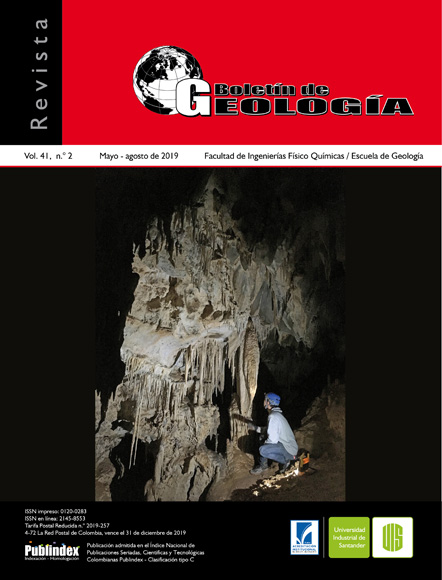Ground temperature model from shallow soundings and remote sensing for geothermal area of Paipa, Boyacá-Colombia
Published 2019-05-29
Keywords
- Geothermal exploration,
- shallow temperatures surveys,
- remote sensing,
- digital processing of satellite images,
- geostatistics
- Pearson ...More
How to Cite
Altmetrics
Abstract
Temperature models were generated from Shallow Temperature Surveys (SST) and Remote Sensing (SR) with Landsat 8 TIRS images for Paipa geothermal area. The temperature range at 20 cm depth fluctuates between 17.04°C and 19.14°C. At 150 cm depth, the temperature values range from 16.81°C to 19.66°C. The normalization of the temperature values in depth (20 cm and 150 cm) as a function of the surface temperature eliminates the effect of the solar radiation and allows to compare the temperatures calculated with SR both in surface and depth. Pearson correlation coefficient measure shows that there are mostly negative correlations in depth (-0,1955) and some positive surface correlations (0,3125) between SST and SR anomaly maps. In turn, an analysis of uranium (38U) (0 ppm and 205,7 ppm), thorium (32Th) (0,6 ppm and 94,2 ppm) and potasio (40K) (0% and 11,8%) anomalies by gamma ray spectrometry, topography (between 2500 mals and 3200 mals) and the estimated temperature anomalies, finding highs and lows with spatial matching between the variables.
Downloads
References
Alfaro, C., Monsalve, M., Franco, J., y Ortiz, I. (2012). Modelo conceptual del sistema geotérmico de Paipa. Grupo de Exploración de Recurso Geotérmicos, Servicio Geológico Colombiano, Bogotá.
Baddi, M., Guillen, O., Lugo-Serrato, O., y Aguilar-Garnica, J. (2014). Correlación no-paramétrica y su aplicación en las investigaciones científicas. Daena: International Journal of Good Conscience, 9(2), 31-40.
Beardsmore, G. (2012). Towards a shallow heat flow probe for mapping thermal anomalies. 37th Workshop on Geothermal Reservoir Engineering. Stanford University, Stanford, California, EEUU.
Becerra-Gonzalez, L., Matiz-Leon, J.C., Ariza-Ariza, O., Borda-Beltran, D., y Medina, J. (2016). Aplicación de imágenes de satélite y de sistemas UAV para la producción de guayaba en la provincia de Vélez, Santander. UD y la Geomática, 11, 46-53.
Borgogno-Mondino, E., and Lessio, A. (2015). Estimation and mapping of NDVI uncertainty from Landsat 8 OLI datasets: An operational approach. IEEE International Geoscience and Remote Sensing Symposium. Milan, Italia.
Carslaw, H.S., and Jaeger, J.C. (1986). Conduction of heat in solids. 2nd edition. England: Oxford Science Publishers.
Coolbaugh, M., Sladek, C., Faulds, J., Zehner, R., and Opplieger, G. (2007). Use of rapid temperature measurements at a 2-meter depth to augment deeper temperature gradient drilling. 32nd Workshop on Geothermal Reservoir Engineering. Stanford University, Stanford, California, EEUU.
Coolbaugh, M., Sladek, C., Zehner, R., and Kratt, C. (2014). Shallow temperature surveys for geothermal exploration in the Great Basin, USA, and estimation of shallow aquifer heat loss. Geothermal Resources Council Transactions, 38, 115-122.
Eslava, J. (1992). Perfil altitudinal de la temperatura media del aire en Colombia. Earth Sciences Research Journal, 1, 37-52.
Farr, T., Rosen, P., Caro, E., Crippen, R., Duren, R., Hensley, S., Kobrick, M., Paller, M., Rodriguez, E., Roth, L., Seal, D., Shaffer, S., Shimada, J., Umland, J., Werner, M., Oskin, M., Burbank, D., and Alsdorf, D. (2007). The shuttle radar topography mission. Reviews of Geophysics, 45(2), 1-33. doi: 10.1029/2005RG000183.
Florides, G.A., and Kalogirou, S.A. (2005). Annual ground temperaure measurements at various depths. Proceedings of CLIMA. Lausanne, Switzerland.
González, L., Vásquez, L., Muñoz, R., Gomes, H., Parrado, G., y Vargas, S. (2008). Exploración de recursos energéticos. Exploración de uranio en Paipa, Iza, Pesca, Chivata (Boyacá). INGEOMINAS, Bogotá.
Kratt, C., Coolbaugh, M., Peppin, B., and Sladek, C. (2009). Identification of a new blind geothermal system with hyperspectral remote sensing and shallow temperature measurements at Columbus Salt Marsh, Esmeralda County, Nevada. Geothermal Resources Council Transactions, 33, 481-486.
Li, M., Liu, S., Zhou, H., Li, X., and Wang, P. (2005). The temperature research of urban residential area with remote sensing. Proceedings IEEE International Geoscience and Remote Sensing, 1514-1517.
Matiz-León, J.C. (2015). Modelo conceptual geológico – geofísico del área geotérmica de Paipa, Boyacá. Grupo de Exploración de Recursos Geotérmicos, Servicio Geológico Colombiano, Bogotá.
Mihalakakou, G., Santamouris, M., Lewis, J.O., and Asimakopoulos, D.N. (1997). On the application of the energy balance equation to predict ground temperature profiles. Solar Energy, 60(3-4), 181-190. doi: 10.1016/S0038-092X(97)00012-1.
Mwawongo, G. (2007). Geothermal mapping temperature measurements. Short Course II on Surface Exploration for Geothermal Resources, organized by UNU-GTP and KenGen. Lake Naivasha, Kenya.
Norini, G., Gropelli, G., Sulpizio, R., Carrasco-Núñez, G., Dávila-Harris, P., Pellicioli, C., Zucca, F., and De Franco, R. (2015). Structural analysis and thermal remote sensing of the Los Humeros Volcanic Complex: Implications for volcano structure and geothermal exploration. Journal of Volcanology and Geothermal Research, 301, 221-237. doi: 10.1016/j.jvolgeores.2015.05.014.
Olmsted, F., and Ingebritsen, S. (1986). Shallow subsurface temperature surveys in the basin and range province - II. Ground temperatures in the upsal hogback geothermal area, West-Central Nevada, U.S.A. Geothermics, 15(3), 267-275. doi: 10.1016/0375-6505(86)90104-5.
Restrepo, L., y González, J. (2007). De Pearson a Spearman. Revista Colombiana de Ciencias Pecuarias, 20(2), 183-192.
Rodriguez, G. (2013). Sondeos térmicos superficiales en el área geotérmica de Paipa, Boyacá. Grupo de Exploración de Recursos Geotérmicos, Servicio Geológico Colombiano, Bogotá.
USGS. (2016). Landsat (L8), Data Users Handbook. Sioux Falls, South Dakota: U.S. Geological Survey.
Velandia, F. (2003). Cartografía geológica y estructural sector sur del municipio de Paipa. Informe Técnico. INGEOMINAS, Bogotá.
Velandia, F., y Cepeda, H. (2004). Geología sector Sur del Municipio de Paipa - Boyacá. Grupo de Exploración de Recursos Geotérmicos, Servicio Geológico Colombiano, Bogotá.

